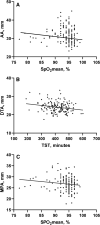Association of sleep disturbance and sleep apnea with the size of the thoracic aorta and the main pulmonary artery
- PMID: 40341711
- PMCID: PMC12062504
- DOI: 10.1038/s41598-025-00385-9
Association of sleep disturbance and sleep apnea with the size of the thoracic aorta and the main pulmonary artery
Abstract
Obstructive sleep apnea (OSA) is associated with an increased prevalence of aortic aneurysm, but the impact of OSA on the subclinical damage of large thoracic vessels remains controversial. Short sleep duration and poor sleep quality has been reported to be related with higher arterial stiffness. In the current study, we aimed to investigate the association of sleep disturbance and sleep apnea with the size of the ascending aorta (AA), descending thoracic aorta (DTA), and main pulmonary artery (MPA). One hundred and fifty-five newly diagnosed OSA patients free of cardiovascular disease and medication were included. In-laboratory polysomnography (PSG) and chest computed tomography (CT) scanning were performed. The sleep duration was defined as total sleep time (TST) as recorded during overnight PSG, with TST < 6 h defined as short sleep duration. Sleep latency (SL), sleep efficiency (SE) and wake after sleep onset (WASO) were used to assess the objective sleep quality, and the Epworth Sleepiness Scale (ESS) was used to assess EDS (excessive daytime sleepiness). The diameter of AA was positively associated with age (B = 0.199, P < 0.001) and diastolic blood pressure (DBP) (B = 0.103, P < 0.001), and was negatively associated with mean pulse oxygen saturation (SpO2mean) (B = - 0.176, P = 0.022). The diameter of DTA was positively associated with age (B = 0.112, P < 0.001), body mass index (BMI) (B = 0.184, P = 0.041), and DBP (B = 0.033, P = 0.024), and was negatively associated with TST (B = - 0.006, P = 0.023). Neither nocturnal hypoxia nor TST were associated with the diameter of MPA or the ratio of MPA to AA (PA/A). The aortic or MPA measurements were not associated with SL, SE, WASO or ESS. In patients with OSA, nocturnal hypoxia and sleep duration were associated with the diameter of AA and DTA, respectively. It is suggested that sleep apnea and sleep disturbance may exert effects on the remodeling and enlargement of thoracic large vessels through distinctive mechanisms.
Keywords: Ascending aorta; Descending aorta; Main pulmonary artery; Obstructive sleep apnea; Sleep disturbance.
© 2025. The Author(s).
Conflict of interest statement
Declarations. Competing interests: The authors declare no competing interests.
Figures



Similar articles
-
Effects of obstructive sleep apnea on the thoracic aorta and the main pulmonary artery: assessment by CT.J Clin Sleep Med. 2021 Jan 1;17(1):3-11. doi: 10.5664/jcsm.8770. J Clin Sleep Med. 2021. PMID: 32876043 Free PMC article.
-
Depressive symptoms are associated with poor sleep quality rather than apnea-hypopnea index or hypoxia during sleep in patients with obstructive sleep apnea.Sleep Breath. 2017 Dec;21(4):997-1003. doi: 10.1007/s11325-017-1550-1. Epub 2017 Aug 19. Sleep Breath. 2017. PMID: 28825197
-
Polysomnography in patients with obstructive sleep apnea: an evidence-based analysis.Ont Health Technol Assess Ser. 2006;6(13):1-38. Epub 2006 Jun 1. Ont Health Technol Assess Ser. 2006. PMID: 23074483 Free PMC article.
-
The association between the phenotype of excessive daytime sleepiness and blood pressure in patients with obstructive sleep apnea-hypopnea syndrome.Int J Med Sci. 2014 May 9;11(7):713-20. doi: 10.7150/ijms.7487. eCollection 2014. Int J Med Sci. 2014. PMID: 24843321 Free PMC article.
-
Obstructive sleep apnea in children: implications for the developing central nervous system.Semin Pediatr Neurol. 2008 Jun;15(2):100-6. doi: 10.1016/j.spen.2008.03.006. Semin Pediatr Neurol. 2008. PMID: 18555196 Free PMC article. Review.
References
-
- Gaisl, T. et al. Prevalence of obstructive sleep apnea in patients with thoracic aortic aneurysm: A prospective, parallel cohort study. Respiration99(1), 19–27. 10.1159/000502892 (2020). - PubMed
-
- Adir, Y., Humbert, M. & Chaouat, A. Sleep-related breathing disorders and pulmonary hypertension. Eur. Respir. J.57(1), 2002258. 10.1183/13993003.02258-2020 (2021). - PubMed
-
- Floras, J. S. Sleep apnea and cardiovascular disease: An enigmatic risk factor. Circ. Res.122(12), 1741–1764. 10.1161/CIRCRESAHA.118.310783 (2018). - PubMed
-
- Gaisl, T., Bratton, D. J. & Kohler, M. The impact of obstructive sleep apnea on the aorta. Eur. Respir. J.46(2), 532–544. 10.1183/09031936.00029315 (2015). - PubMed
MeSH terms
LinkOut - more resources
Full Text Sources
Medical

